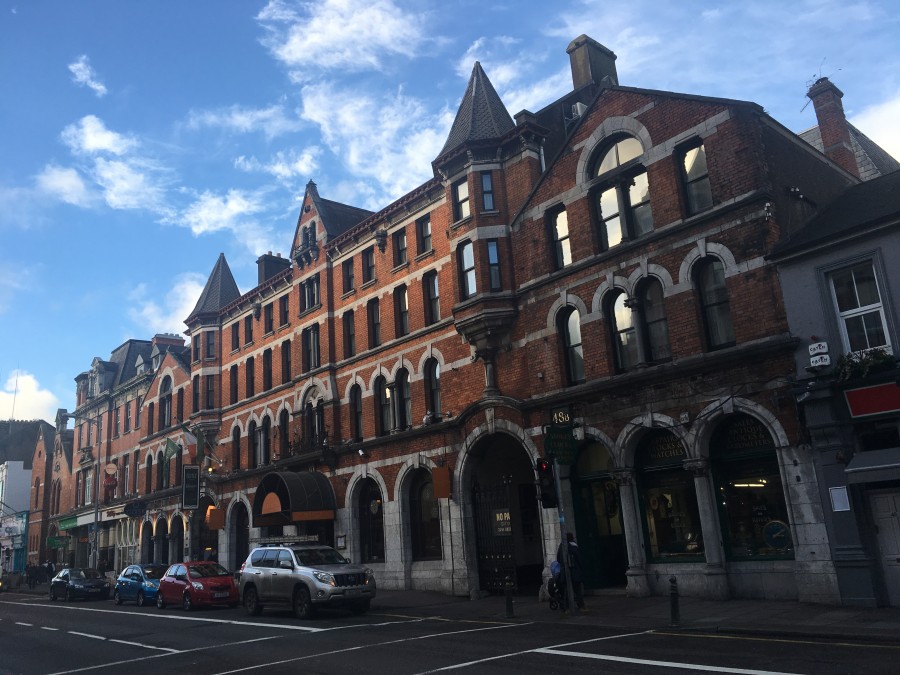Kieran’s Our City, Our Town Article,
Cork Independent, 1 February 2018
Stories from 1918: Dobbin, Ogilvie and Hibernia Buildings
The first week of February 1918 brought a focus to picketing and strikes on Cork’s streets. Picketing was held outside Messrs Dobbin, Ogilvie and Co, on King Street (now MacCurtain Street). The strike concerned 54 workers, 37 females and 17 males.
A prominent member of the Transport Workers and General Union, when interviewed in the Cork Examiner described the origins of the dispute. The dispute has its origin in demands made in October 1917 for 18s per week for female hands who were being called upon from time to time “to perform heavy work, men’s work, hoisting of full barrels, etc”, and 30s per week for men, which included firemen. An advance of 2s per week was offered to, and rejected by the men on that occasion, and an advance of 5s per week to female workers, which was accepted.
The men were told they would receive more favourable consideration if they left their trade union. They did not and were fired. The firm gave references to them, and days later five workers at the firm were each asked to perform the work of those put off. They refused, got a week’s notice and the rest of the workers decided to strike. Grievances at the company were not resolved until 1919.
The business, Messrs Dobbin, Ogilvie and Company, which was established in the year 1855, was a successful enterprise. It developed to such an extent that a larger premises was needed. The company moved from premises on the South Mall and on Princes Street. In 1877, newly erected buildings, known as the Hibernia Buildings, on King street were occupied, and trade was further developed.
In the Irish Builder newspaper for 1883, a fire is recorded on the site. The paper recorded that the business comprised three buildings; the main or centre structure contained the counting-house and the general warehouse, in which all kinds of merchandise were stored. Brandies, whiskeys, oils, chandlery, and other inflammable materials were among the goods that filled this large section. At the right stood the building in which the confectionery was manufactured. The building at the left side was the one in which the important work of tobacco spinning was carried on. The tobacco factory was deemed to be fitted with “machinery of a very expensive and elaborate character”.
Following the fire, some of the building was remodelled by Henry Arthur Hill and was known for its cupola atop it. In the year 1891 the business was converted into a joint stock company, and continued to expand. Like many other trading companies, it had its good years and lean years. It was well known for its Cordangan Mixture, Douglas Mixture, Irish Roll, and Plug as well as its jams and jelly marmalade. For many years, the company, in addition to its general business and tobacco manufacture, was engaged in the army canteen trade on a very considerable scale, and the cessation of World War I involved a largo reduction in the extent of the company’s operations. In the early 1920s, the establishment of the Customs barrier between Great Britain and the Irish Free State involved a further extensive loss of business, as the company’s cross-Channel tobacco trade, a large percentage of the total, was relinquished. The firm went into voluntary liquidation in April 1926.
In Hodges Cork and County Cork in the Twentieth Century (1911) James Ogilvie is listed as born in 1840 and educated privately. He was as a Justice of the Peace for the county and city, member and ex-Chairman of the Cork Harbour Commissioners Board, Chairman of the Cork Spinning and Weaving Company, Ltd, Director of Eustace and Company, Ltd, Director of F H Thompson and Son, Ltd, Director of the Cork Commercial Building Company, ex-President of the Cork Literary and Scientific Society, member and ex-President of the Cork Incorporated Chamber of Commerce and Shipping, Trustee and Member of the Committee of Management of the Cork Savings Bank. He died at his residence in Queenstown in September 1910.
In his obituary on 2 February 1942 in the Cork Examiner Sir Alfred Dobbin was born in 1853, the son of Leonard of Belfast, and later of Cork. Early in life he displayed a great business acumen, which prompted him to play no small part in the building up of Cork’s commercial importance. He was appointed High Sheriff of Cork in 1900 and in the same year was knighted by Queen Victoria. Within a few years he was also appointed Deputy Lieutenant for Cork City, a position which he held until the change in regime abolished the post.
During the Irish War of Independence the Dobbin house at Frankfort, Montenotte, was totally destroyed by fire. On another occasion he was fired upon but it was made public at the time that the bullet hit a button in his clothing and was deflected, thus saving his life.
Sir Alfred’s first wife, Miss Margaret Reid Ogilvie died in 1883. after seven years of married life. Lady Kate Dobbin was the second daughter of the late Mr William Wise, solicitor, of Bristol. Both Sir Alfred and Lady Dobbin took a keen interest in art. Kate Dobbin was a well-known exhibitor at exhibitions of paintings and photographs.
Captions:
931a. Sir Alfred Dobbin, in Hodges Cork and County Cork in the Twentieth Century, 1911 (source: Cork City Library)
931b. James Ogilvie, in Hodges Cork and County Cork in the Twentieth Century, 1911 (source: Cork City Library)
931c. Former Hibernia Buildings, MacCurtain Street, built initially by Dobbin, Ogilvie & Company (picture: Kieran McCarthy)


